Treasures sinking in the seabed for centuries reveal much information about the civilisations in the past. Archaeologists salvaged them from the shipwrecks and now show the public the important position of Việt Nam in the map of Maritime Silk Road.
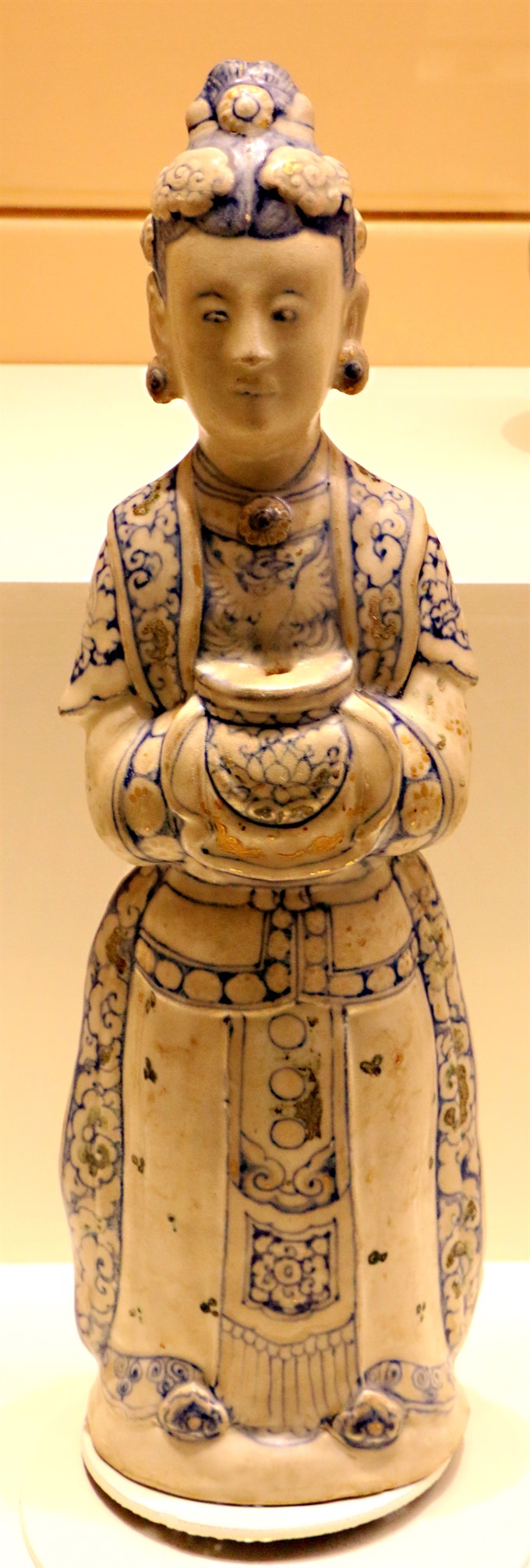
A statue of a noble woman dating from the 15th century found on the Cù Lao Chàm shipwreck. VNS Photo Đoàn Tùng
"The Maritime Secrets Revealed from Ancient Ships" exhibition is showcasing more than 500 objects collected from shipwrecks in Việt Nam’s territorial waters from the 15th–18th centuries.
The Việt Nam National Museum of History hosts the five-month exhibition until May 18. Since its opening, the exhibition, the first of its kind in the country, has attracted many visitors and researchers as this is the biggest exhibition of shipwrecks held so far.
Underwater treasures
In Việt Nam, from the early time of Đông Sơn, Sa Huỳnh and Óc Eo cultures (more than 2,000 years BC), the people started to use maritime routes for trading activities, according to Nguyễn Văn Cường, director of the museum.
The Maritime Silk Road originated in China, crossed the Indochinese Peninsula and tended to the Arabian Peninsula. It ended at Europe. Việt Nam lies on the strategic position of the route with various port, serving as transshipment and stopover locations for merchant ships.
Cường stressed that many shipwrecks in the Vietnamese seas hide mysteries of different civilisations of the world.
The original and unique artefacts at the exhibition just revealed a small part of the secrets on the seabed, he said.
The exhibition is divided into four areas featuring Vietnamese seas and maritime trade; Vietnamese ceramics; the Maritime Silk Road; and ships excavated from Việt Nam’s seabeds.
The first shipwreck was discovered and excavated at Hòn Cau region (Bà Rịa-Vũng Tàu Province) in 1990. Since then, about 10 excavations have been implemented scouring ancient ships found in the waters near Bình Thuận Province, Hòn Dầm (Kiên Giang Province), Bình Châu (Quảng Ngãi Province), and Cù Lao Chàm (Quảng Nam Province).
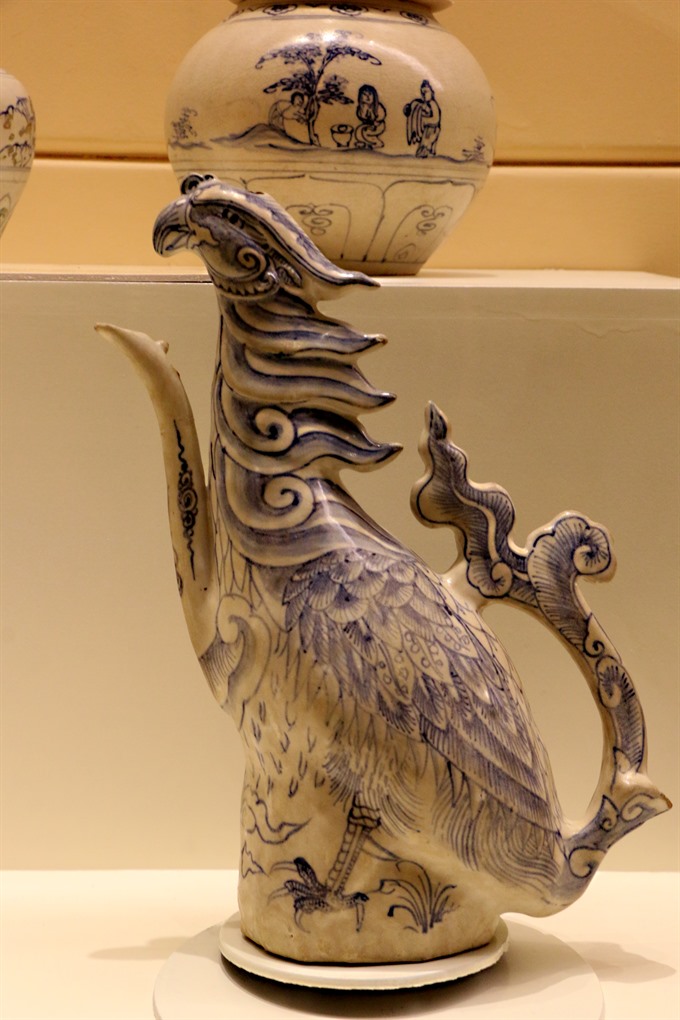
A phoenix-shaped ewer with blue and white glaze found on the Cù Lao Chàm shipwreck. VNS Photo Đoàn Tùng
With 240,000 valuable artefacts found, the Cù Lao Chàm shipwreck became the biggest discovery of the archaeologists. The ancient ship was excavated from 1997 to 2000.
The most noteworthy thing is that scientists excavated remains of 11 people on board. The exhibition displays a skull of a woman aged about 20 and her ruby ring.
When it was discovered, the ship sank at the depth of 70-72m below the sea level. The remaining part of the ship is 29.4m long and 7.2m wide.
Different objects were found including ceramics, bronze objects, metal kitchenware, Chinese coins, mortars, spices, seeds and belongings of the crew.
Ceramics discovered on the Cù Lao Chàm shipwreck varied in types, glazes and decorative patterns. They had blue, celadon, white, brown and multi-coloured glaze. They had special features of Vietnamese ceramics in the 15th century, different from characteristics of Chinese ceramics at that time.
“The decorative patterns with diverse themes proved the creativity, artistic and technical skills of the then artisans,” said director Cường.
In an ancient ship found near Bình Thuận (excavated in 2001-2002), archaeologists obtained more than 60,000 artefacts, most of which were blue and white ceramics, as well as a significant amount of coloured porcelain. The ship was at the depth of 39-40m. It was 23.4m in length and 7.2m in width.
“The scientists acknowledged the similarity of ceramics on the Bình Thuận ship and Witte Leeuw (the Dutch ship sank in 1613 in a fight with a Portuguese one while trading goods from Asia),” Cường said.
“This suggested that the Bình Thuận ship may be one among the number of Chinese ships carrying ceramics to export to the East India Company,” he said.
At the archaeological site near Hòn Dầm, about 16,000 Thai pottery artefacts were found buried in sand. Scientists have also unearthed brown and ivory-glazed ceramics as well as antiques made from copper. They identified that the Thai ceramics were produced in the Suphanburi and Sawankhalok kilns in Thailand in the 15th century.
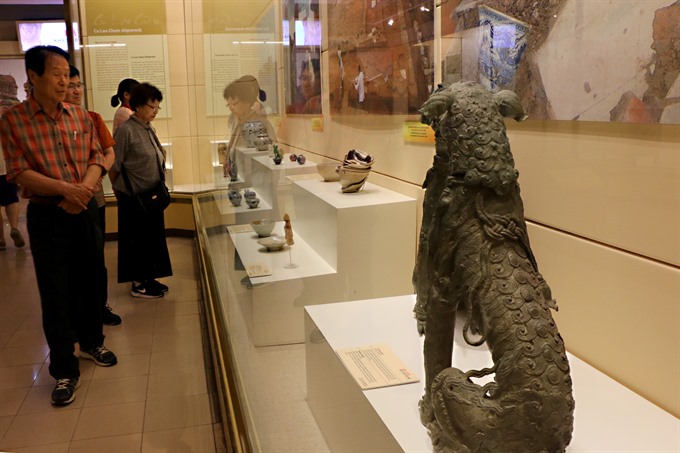
People contemplate the fantastic artefacts at the exhibition. VNS Photo Đoàn Tùng
An ancient ship found near Cà Mau was excavated at a depth of 35m. People found 130,000 objects originated from China. Themes of decorative patterns on these objects are rich with Chinese tradition and followed European requests for products types. The ceramics presented mould carving technique, engraving and drawing under or over glaze and a combination of different techniques.
“The excavations have provided us priceless materials and objects, giving new insight into underwater archaeology,” Cường said.
"The exhibition brings much emotion for visitors with precious artefacts. It’s a rare chance to discover mysteries of the seabed.”
Underwater archaeology finds the way
Bùi Minh Trí, director of the Centre for Royal Citadel Studies, said underwater archaeology leads a new way to discover the history.
“The artefacts have been preserved well underwater, they are not mixed with each other at different historical periods like the artefacts underground,” he said.
“The findings of the underwater excavations bring great values in term of art, history and society.”
Trí is excited to talk about ceramics produced in the 15th century. He highly appreciated the talented skill of the artisans.
“The division of labour was very clear, some artisans were in charge of burning ceramics, others were responsible to paint. They used brushes to sketch the patterns and paint difficult colours on the ceramics, then burned them again at 1,200 degrees Celsius.”
“The patterns illustrated lively the social life. For example, a couple of birds symbolised spring and happiness, a peony symbolised aristocracy and noble women.”
It’s amazing to contemplate beautiful ceramics ranged from 3cm-high porcelain vases to 56cm pottery jars with swan patterns, which has been recognised as a National Treasure in 2012. But they have had a long journey to be salvaged from the seabed to the museum.
The process is difficult beyond words, said archaeologist Nguyễn Đình Chiến who directly took part in the excavations of the shipwrecks.
“Vietnamese underwater archaeology started in 1997, we soon realised that the work was so difficult and required much more money than any other excavations underground,” he said.
“We were trained in underground archaeology. We began approaching underwater archaeology with the help of foreign specialists, then we had a chance to join short-term courses and conferences abroad to self-study.”
Underwater excavations are also costly. For example, the excavation of the Cà Mau shipwreck costs US$1 million.
“At the depth of 30m, divers can approach the Cà Mau shipwreck. Meanwhile for the site at the depth of 70m like Cù Lao Chàm shipwreck, it took $6 million for using modern equipment.”
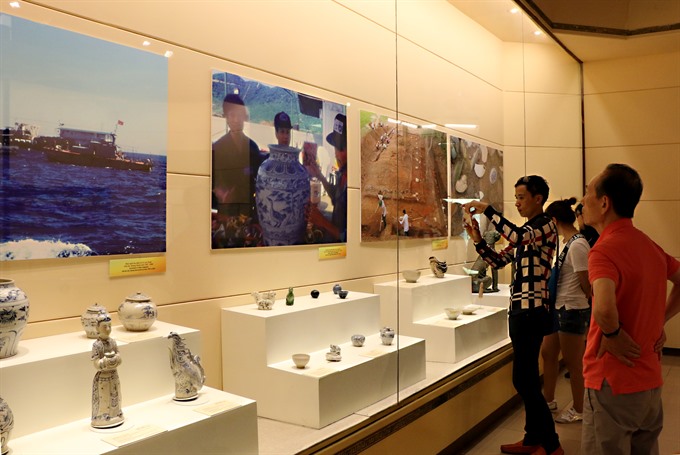
The exhibition has attracted many visitors and experts as it is the first of its kind in Viet Nam. VNS Photo Đoàn Tùng
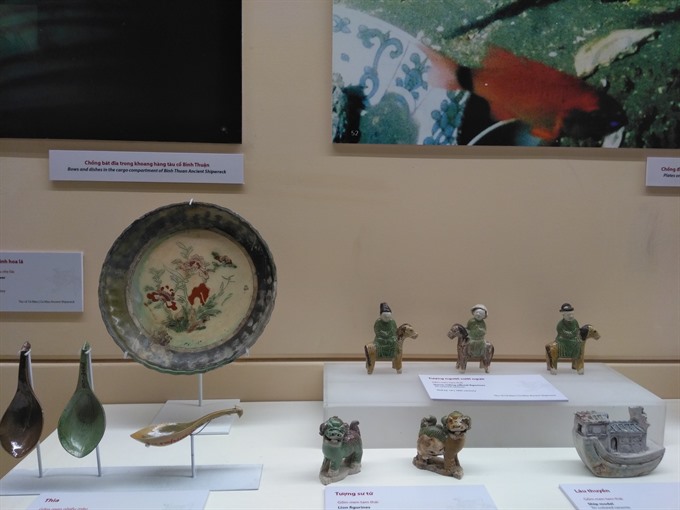
Beautiful ceramics dating from the 18th century found on the Cà Mau shipwreck. VNS Photo Minh Thu
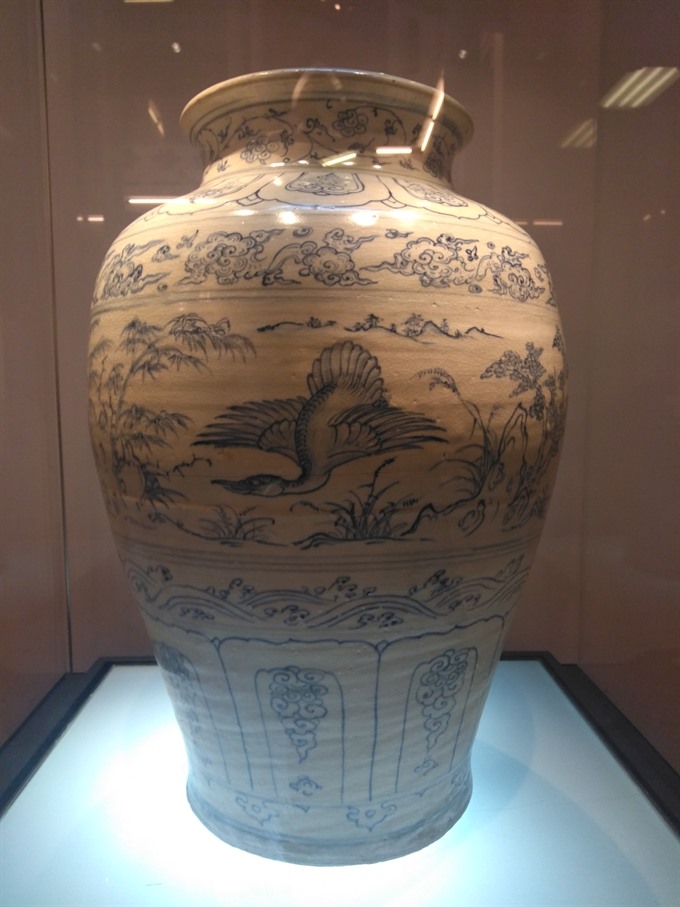
This swan jar dating from the 15th century was recognised as a National Treasure in 2012. VNS Photo Minh Thu
Chiến revealed that the national budget couldn’t afford such an amount of money for archaeology. The Ministry of Culture, Sports and Tourism called for sponsorship and investment from foreign partners and domestic enterprises. Then a part of the collected artefacts would be auctioned and some benefits would go to the investors.
The obstacles led to the loss of precious artefacts. When the archaeologists found the Cà Mau shipwreck, they collected 60,000 objects. Then the artefacts that were seized from illegal excavators and traffickers increased the total number of artefacts to 130,000. The number of trafficked artefacts proved the necessity of protecting the shipwreck site.
According to Chiến the Vietnamese sea territory hides a huge potential of shipwrecks but once the site is found, it needs to be protected.
“We have to spend money to circle around the shipwreck to protect the site, then a large number of divers and devices will be used to excavate,” said Chiến.
“When the artefacts are salvaged, we would have to research and build up scientific documents for them then organise exhibits.”
Chiến suggested that the experts should build up scientific documents for the artefacts then digitalise them to preserve and exhibit.
“We have published a book called Ceramics Found in the Shipwrecks some years ago, it’s a good work to bring the shipwreck legacy closer to the public,” he said.
“It’s a regret that many artefacts collected from the Cà Mau shipwreck are still preserved at the Cà Mau Provincial Museum, so people don’t have a chance to contemplate them at the exhibition.”
Chiến recommended that the museums should enhance to the connection and co-operation.
Russian historian Yuri Kutyrev visited the exhibition and hailed that the artefacts were very beautiful and fantastic, reflecting the talent of Vietnamese artisans as well as the development of pottery making.
“The situation of trafficked artefacts happens everywhere, not only in Việt Nam but shipwreck still needs to be excavated to show the people, it’s the history.” VNS